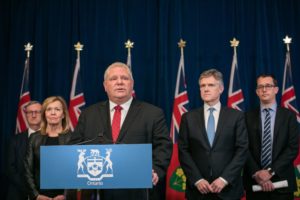On Thursday, the Ontario government announced the 2017 Long Term Energy Plan (LTEP), which includes long-term projections through 2035, for energy supply and demand, residential and industrial hydro costs, fuel consumption, nuclear refurbishment, energy storage, net metering, the electrification of other sectors, and more.
Prior to the release of the report, two members of OSPE’s Energy Task Force attended an ‘invitation-only’ technical briefing with the Ministry of Energy. OSPE officials later attended the ‘Energy Innovation in Ontario’ event with Minister Glenn Thibeault.
Reflecting on the LTEP technical briefing, the industry event with the Minister, and the report itself, OSPE’s Energy Task Force has determined ‘the good, the bad and the ugly’ of Ontario’s 2017 LTEP from an engineering perspective:
The Good:
The government should be complimented for creating a LTEP that is a significant improvement over the 2010 and 2013 plans. The 2017 LTEP includes the following improvements that OSPE has called for:
More Realistic Load Forecasting
- Conservation plans and rising electricity prices have reduced demand for electricity in Ontario. OSPE was the first organization to identify this trend and signaled to government that the 2010 and 2013 LTEPs had load forecasts that were too high. Actual demand later confirmed that OSPE’s concern about an excessive load forecast was correct. The 2010 and 2013 plans resulted in the procurement of too much generation that is difficult and expensive to integrate into Ontario’s grid.
The Right Technology for the Job
- Commitment to all forms of low emission generation technologies based on best economic value, using competitive markets rather than pre-ordained supply mixes that are not necessarily best for Ontario’s unique low emission grid.
A Place for Natural Gas
- Respect for the important role natural gas plays in Ontario’s energy systems—taking a balanced approach that avoids misguided support for a single fuel or technology without consideration for costs and unintended consequences.
Integrated & Intelligent Systems
- Recognition that integrated energy systems using smart technologies are on the horizon for the mass market. This will afford customers choice to determine the greatest value by balancing priorities of affordability, sustainability, and reliability. This includes using off-peak renewable power for homes, businesses and personal transportation while addressing peak demands with natural gas resulting in a net-reduction in carbon emissions versus current practices.
Calling for Backup
- Recognition that the continued scale-up of renewable power will cause Ontario’s power system to be unreliable by 2020 if it does not have natural gas backup when wind and solar are insufficient or non-productive.
Improved Cost Recovery
- Recognition that global adjustment (GA) is primarily a capacity acquisition cost and should be recovered through capacity (demand) charges, rather than through energy charges. Applying the GA via energy charges undermines the deployment of storage technologies and makes it impossible for Class B consumers (less than 500 kW demand) to use surplus clean electricity at the same low price as Class A (large industrials) and adjoining power systems.
- Support for storage technology and energy innovation (new technology) that could make Ontario a world leader. New pricing plans/market renewal are central for the success of these investments and will be closely monitored by OSPE.
Market & Consumer Driven Choice
- Commitment to a market driven approach to energy development and consumer choice, so innovative technologies can be developed in Ontario to benefit the province’s local economy, both through domestic and export sales.
- The plan also signals intentions to increase system flexibility and competitiveness by incrementally moving away from inflexible long-term electricity contracts and moving towards a market-based approach through a Market Renewal Initiative.
The Rise of EVs
- Commitment to support the deployment of electric vehicles (EV) and hydrogen fuel cell electric vehicles (FCEV). OSPE is a General Member to Ontario’s Electric and Hydrogen Vehicle Advancement Program (EHVAP) and has called on the government to take action to support ambitious market penetration goals. This program will reinforce recommendations that OSPE’s policy advisory committees have made at Ontario Building Code meetings and other ministry initiatives, such as enhanced public charging infrastructure, grid improvements to facilitate community and household charging stations, EV parking incentives and smart cities.
- Commitment to deploy both electric vehicle and clean hydrogen technologies in an economic manner.
Putting the Brakes on the Air Source Heat Pumps Strategy
- The plan backed away from the aggressive deployment of air source heat pumps in place of natural gas for hot water and space heating. Natural gas prices and carbon prices are still much too low to make deployment of air source heat pumps economic for most consumers.
Understanding that Price is Key
- Commitment to keep electricity rates as low as possible. Low electricity rates are essential to leverage our clean power system to reduce fossil fuel use in other sectors of the economy.
The Bad:
There are some areas where the government could stand to improve its communications and forward-looking plans with regard to the 2017 LTEP:
The Need to Improve Transparency in Cost
- The representation of average household electricity cost in dollars per month has hidden the increased cost of electricity on a per kWh basis in the 2017 LTEP. The Ministry is distorted in the 2017 LTEP. The Ministry has reduced the average household consumption in their modeling to 750kWh (the new value used by the OEB) versus historical data at 800kWh. To be more forthright with the public, the ministry should have also presented the average cost of electricity per kWh for improved clarity and transparency.
The Ugly:
The 2017 LTEP has two fundamental flaws that need to be addressed before the next LTEP is developed:
Competitive Misalignment with US Jurisdictions
- In the United States, electricity system transformation is fundamentally different than Ontario’s, and will limit future energy price increases in the US to approximately half of the price increases that are anticipated in Ontario.
- Over the next 20 years, this will make Ontario’s electricity less competitive than neighbouring US electricity costs. If Canada remains in the NAFTA free trade zone, Ontario needs to deal with this divergence in a fundamental way. The US uses tax credits and merchant plant bankruptcy processes to keep electricity costs lower than Ontario’s in approximately half of all states at the present time.
- Ontario needs to find a way to remove energy transformation costs that are not competitive with the lower costs in the US, especially for businesses. In light of the US federal government’s current approach to energy pricing and environmental regulations, simply charging Ontario’s Fair Hydro Plan deferral account onto consumer electricity bills after 2021 is not a long-term solution.
The Need to Establish an Interruptible Retail Electricity Market for Surplus Clean Electricity
- Reducing emissions in the non-electrical sectors will be very expensive for most applications because there are few low cost low emission options available. However, a clean power system like Ontario’s creates significant amounts of surplus clean electricity due to the production characteristics of clean generation.
- Rather than exporting that surplus at low market prices, Ontario needs to find a way to allow Ontario consumers to use that clean surplus electricity to economically displace fossil fuels in the non-electrical sectors.
- Clean electricity has a very low marginal cost of production of less than 1 cent/kWh. Surplus clean electricity can be used in an interruptible retail electricity market to economically displace fossil fuels in other sectors when that surplus is available. However, to do so requires that Ontario establish an interruptible retail electricity market that can offer this surplus at its wholesale market price, with no other markups.
- Once an interruptible retail electricity market is established, Ontario companies can develop load management controllers, smart grid algorithms, and fuel switching equipment to take advantage of surplus clean electricity, thereby reducing fossil fuel use, emissions in non-electrical sectors of the economy, as well as consumers’ total energy costs. That interruptible market can also be used to import clean surplus electricity from adjoining jurisdictions to economically reduce emissions in non-electrical sectors using relatively low-cost fuel switching technologies.
Do you have anything to add? Share your thoughts on the 2017 LTEP in the comments section below.






Pingback: OSPE Policy Recommendations Featured Prominently in Ontario PC Election Platform • Ontario Society of Professional Engineers